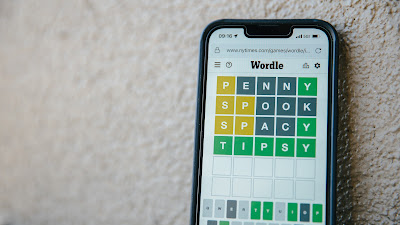The Cost Of Missing Feedback Loops
 |
| Photo by Nils Huenerfuerst on Unsplash |
There are a lot of subtle feedback loops that encourage continued participation. Seeing people’s Wordle blocks on social media is not just a reminder to play but also encouragement to share your own results. A class format that gives verbal instructions one step at a time encourages students to keep up their work pace.
It only takes a small quirk or disability to push someone out of those feedback loops.
My up-close vision is poor and my glasses improve it to mediocre. I accommodate myself by doing things on my computer instead of my phone whenever possible. I switched my gym membership in late December and was determined to start going to the strength-and-socializing class twice a week. You need to sign up ahead of each class and the class is popular so if you wait too long you won’t get in. The time registration opens isn’t written down, but it’s a sociable class and the students share tips.
It took me a while to even realize that there was a problem I needed to solve. I thought when I didn’t register in time I’d still go and just do other stuff at the gym. I assumed after the January increase in gym use died down it’d be much easier to sign up late and still get in. Neither of those things went the way I thought they would.
So I started asking the other students when they were signing up, and I worked at doing the same but kept finding that registration wasn’t open yet. It took another few weeks before it occurred to me that maybe things were different between the regular web page and the phone app. Because I wasn’t using the same device as the other students, I wasn’t in the feedback loop where socializing helped class logistics helped regular attendance helped socializing.
In mid-March I switched to registering only on my phone and setting a phone alarm and that worked to get me signed up for strength class twice a week. Now that I’m benefitting from the class schedule, I’m seeing my strength improve, which makes class more fun. I’m finally in the feedback loop!
Figuring out the logistics of regularly attending an exercise class at the gym takes most people less than three weeks. A wait-and-see attitude plus poor vision meant it took me nearly three months.
That was a boring anecdote about a voluntary, low-stakes, grownup situation.
- understand instructions
- get out materials
- cut a shape out of paper
- raise a hand in response to a teacher saying “Does anyone have any questions?”
Which meant missing the informational feedback loop of hearing the instructions for a step while ready to start that step.
And missing the approval feedback loop of keeping up with the class and feeling good about having worked fast enough.
And missing the social feedback loop of chatting with classmates about the step everyone was doing at the same time.
So the school STEM projects of cutting and taping cardstock into parts for simple machines didn’t result in experiencing how following instructions resulted in having a fun gizmo at the end of class. Getting a satisfying result from following instructions is important reinforcement for students’ intrinsic motivation. Trying as hard (or harder!) than classmates and not getting the satisfying result is bigger than a one-time letdown.
Teachers and staff didn’t seem to understand why my kid was so stressed out over a class that most kids found fun and easy. They acted like finishing it at home with Mom would balance everything out.
A small disability or quirk can mean someone has a fundamentally different and worse experience. An accommodation that seems sufficient for the person’s hurdle might not be enough to get them into the feedback loops that support most people.



Comments
Post a Comment